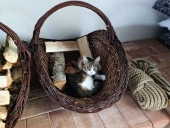Hello! Just wanted to chime in since I am currently homesteading in the Panhandle (Zone

. Not sure I can provide much info since I have only been at my current property for about 1.5 years and in FL for 3.5 and I absolutely do not have a green thumb, but here is what I have found since I started;
Around here (anywhere that has any land) there are so many pine trees so a lot of the soil is acidic. Good for blueberries and acid loving plants. The ground also gets pretty waterlogged at time so good for plants that like a lot of water. From what I have heard, the soil is a hell of a lot better just an hour inland (I am right on the coast).
The only thing I have successfully grown is cucumbers. Even with my terrible gardening skills and the wrath of my chickens, they did awesome. I grew some baseball sized watermelon, but I think it's too hot here for them to get much bigger. Haven't tried a whole lot of other things. There were grapes already growing here when I got here. They do pretty well but I can never get them ripe before the birds steal them...
The winters are inconsistent, some years there is enough cooling hours and I have seen a ton of people with citrus trees covered in fruit. This year I don't think it has gotten in the 40s for more than 3 days total so far...
The bugs are insane. It's December and I'm covered in mosquito bites right now. Also, fire ants are everywhere.
I have goats, and a lot of people do around here, but they are not well suited to this environment. The wet grounds and heat are perfect breeding grounds for parasites. You can keep them, but you just have to have a great parasite control program.
I also have chickens, ducks, and peacocks who all free range. There is a ton of stuff for them to eat year round. They are pretty easy but predators are always a concern. We lost quite a few birds at first but the peacocks have actually been great livestock guardians for us. They chase anything that isn't supposed to be in the yard away. Since they have been totally free ranged, we have only lost small birds to hawks, not much we can do about them but they seem to leave the adult birds alone...
Oh and the heat! It get's pretty miserable in the summer but the way we deal with it is to actually keep our AC at a higher temperature than most. I find that around 78 feels awesome when you have been working outside all day and it makes it easier to transition to the hot temperatures outside. I know a lot of people keep there AC closer to 70 but they have a much harder time with the heat. And lots of water helps too...When it's really hot, it's hard to work for more than a couple hours outside but the winters are so mild that you can get so much outside work done in the winter that you wouldn't be able to do a couple hours north of here.
Anyway, probably more than you wanted to know, just wanted to share what I've experienced. I lived in NJ and MA prior to here and they both were miserable in the winter. Despite the bugs and summer heat, I really love it here and I think there is a lot of homesteading stuff you can do here that wouldn't be nearly as easy/possible any further north...





























 1
1












 There is a lot of cattle-raising in north Florida; I think it might be the main farming activity there.
There is a lot of cattle-raising in north Florida; I think it might be the main farming activity there.











 . Not sure I can provide much info since I have only been at my current property for about 1.5 years and in FL for 3.5 and I absolutely do not have a green thumb, but here is what I have found since I started;
. Not sure I can provide much info since I have only been at my current property for about 1.5 years and in FL for 3.5 and I absolutely do not have a green thumb, but here is what I have found since I started;




















 1
1






























